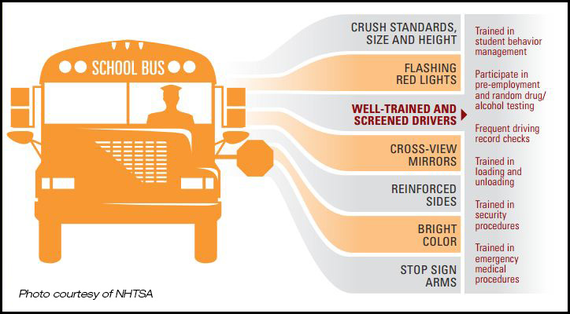
You've packed the lunches, bought the notebooks and zipped up the backpacks, anxious for the first day back at school. But before that first bell rings, make sure safety is a priority for your family.
Whether it's educating your children on the basics of crossing the street or how to prevent injuries on the playground, send them back to school this season knowing that they are prepared to safely navigate through their day.
The wheels on the bus: safety on and around school buses
School buses are the safest mode of transportation for your children. In fact, according to the National Highway Transportation Safety Administration, students are about 50 times more likely to arrive at school alive if they take the bus than if they drive themselves or ride with friends, and eight times safer than with their own parents and guardians in the car. School buses are inherently crafted with safety on the forefront: bright colors, cross-view mirrors and trained drivers.
Even though the safety features are impressive, it's still crucial to make sure your children know how to behave on and around the bus. Share these tips*:
- When the bus arrives, stand at least three giant steps (6 feet) away from the curb.
- Never walk behind the bus. If you drop something near the bus, tell the bus driver. Never try to pick it up first because the driver may not be able to see you.
- When on the bus, find a seat and stay seated throughout the ride.
- Keep your head, arms and hands inside the bus at all times.
- Clear aisles of books or bags, as they are tripping hazards and block the way in an emergency.
- When you reach your exit, wait for the bus to stop completely before getting up from your seat, and use the handrail down the stairs.
- If you meet your child at the bus stop, make sure you wait on the same side of the street where he/she will be dropped off.
Take the load off: preventing backpack injuries
Did you know that one of the most common school supplies can also be one of the most dangerous? Backpacks cause more than 7,300 injuries annually, according to an estimate from the U.S. Consumer Product Safety Commission. Injuries can range in intensity from small bruises on the shoulders to back strains and fractures.
A backpack should weigh no more than 10 to 20 percent of the child's body weight. Warning signs that may indicate your child's backpack is too heavy include: pain or tingling, changing posture or red marks. If you notice any of these symptoms, you may want to consult your child's physician or consider buying a backpack better suited for their needs. Here are some quick tips for buying a backpack before you hit the store:
- Look for a padded back to help reduce pressure and enhance comfort.
- Multiple pockets can help evenly distribute weight between the back, shoulders and torso.
- Try finding one that has compression straps on the sides or bottom - this helps keep contents closer to the back.
- Consider reflective material so your child can be seen by motorists.
Swing into a safe school year: playground safety tips
For most children, recess is the best part of the day. They get to see their friends, eat lunch and, most of all, have fun on the playground. But for parents, there is some concern over how safe playgrounds actually are. The U.S. Consumer Product Safety Commission estimates more than 200,000 children annually visit hospital emergency rooms because of playground injuries - 80 percent of which occur from falling to the ground.
These injuries are preventable, however, with some guidance and education:
- Encourage your child only to use playgrounds with a soft surface, such as sand or rubber. Avoid playgrounds with concrete surfaces.
- Children under the age of four should only use climbing equipment with adult supervision and assistance.
- Inspect the playground for any manufacturing defects or old equipment that might need replacing.
Starting a new school year is a fun and exciting time for children and parents alike. By following these tips, you can help ensure that your child has their best -- and safest -- year yet. Don't forget to check out nsc.org/back2school for more tips on teen driving, bullying and biking.
Visit the National Safety Council at nsc.org and follow us on twitter at @NSCsafety.
*According to First Student, the largest provider of student transportation services in North America
